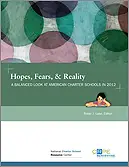One of the main goals of the charter school movement at its founding was to provide new school options for families that wanted and needed them. Another was to foster innovation, for charter schools themselves and traditional public schools around them. Are charters living up to those promises?
Edited by Robin Lake, the 7th edition of Hopes, Fears, & Reality focuses on growth and innovation and presses charter leaders to consider whether they are fully using their flexibility and autonomy on behalf of students. Experts assess the national landscape and provide possible guidance for the charter sector in light of the demand for better schools, impending Common Core standards, and tight budgets:
- Jeffrey Henig, a political scientist at Columbia University, explores whether charter schools, long a primarily urban endeavor, are likely to proliferate in suburban areas, and whether such growth would diminish the sector’s historical focus on equity for disadvantaged students or, perhaps, enhance it.
- Ethan Gray, who directs the Cities for Education Entrepreneurship Trust, argues that cities cannot wait for established and successful charter school networks to build schools in their area. Instead, he writes, cities can and should expand opportunities for children by incubating charter schools on their own.
- Michael Horn, director of the Christensen Institute, explains that while many charter schools have succeeded in helping students, they have done so with an educational model that differs only at the margins from traditional schools. Only now, and only in small numbers, he writes, are charters beginning to experiment with blended learning, an innovative way to deliver instruction more efficiently and effectively, in part through technology.
- Suzanne Simburg and Marguerite Roza, fiscal analysts at the Edunomics Lab at Georgetown University, lay out the cost savings possible if blended learning were adopted by all U.S. public elementary schools, not just charter schools. According to the authors, such a fundamental reorganization of the way teachers and class time are used could save $10 billion total in labor costs that districts could invest in other uses.
Suburban charter schools, online instruction, and cities getting into the charter school creation business are controversial topics. But as the sector continues to grow steadily—about 6,000 charter schools now educate more than 2 million U.S. schoolchildren—and as budgets remain tight, it is crucial that charter leaders, funders, policymakers, and educators think expansively about how to best serve students. This year’s edition of Hopes, Fears, & Reality offers provocative new ways to think about the challenges and opportunities ahead.




